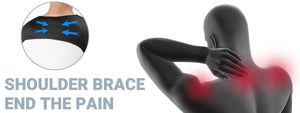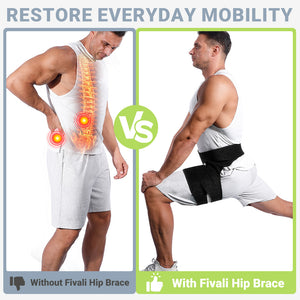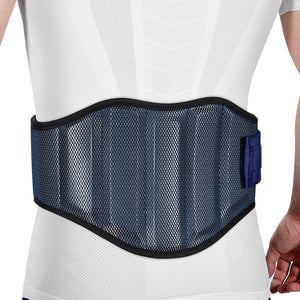How to Wear a Back Brace for Lower Back Pain

How to wear a back brace for lower back pain has become a popular search topic on Google.
According to a WHO report, approximately 619 million people experienced lower back pain in 2020, and the number is projected to rise to 843 million by 2050 [1].
People of all age groups can develop lower back pain, and most will experience it at least once in their lifetime. Therefore, this article will discuss in full length how a back brace helps address lower back pain and exactly how to wear a back brace for lower back pain.

Understanding Lower Back Pain: Causes and Types
We must first develop a basic understanding of this symptom to learn how to wear a back brace for lower back pain. So, what causes lower back pain? Is pain in the lower back all the same?
Lower Back Anatomic Structure
The lower back is right above your hips. Five bones stack together, forming the “backbone” of this area, along with many muscles and tendons.
The lower back carries the most weight of your upper body while supporting various movements such as twisting, bending, and lifting, rendering it susceptible to sprain and damage.
There is a natural inward curvature in your lower back. It plays a pivotal role in:
- Balance the weight of your head atop your spine
- Distribute upper body weight
- Alleviate stress in the lower back
What are the Common Causes of Lower Back Pain?
As we search for “how to wear a back brace for lower back pain," we often wonder how to pinpoint the location and maximize the efficiency of the back brace. In this section, we will examine the common causes of lower back pain and discuss how to manage and prevent this discomfort with a back brace effectively.
- Muscle Strain and Sprain
Back pain often results from strains and sprains, which occur when muscles, tendons, or ligaments are stretched beyond their normal limits. This can occur due to improper lifting techniques, sudden movements such as sneezing or bending, or excessive exertion.
- Degenerative Conditions
Our bodies naturally age over time, resulting in degenerative changes in the spine and muscles. Osteoarthritis, disc degeneration, and spinal stenosis are common conditions in this circumstance.
- Injuries and Accidents
Accidents such as falls, car accidents, or sports injuries can lead to fractures in the spine. Certain conditions, like spondylolysis or osteoporosis, increase the risk of spinal fractures by weakening the bones.
- Poor Posture and Biomechanics
Poor postures, such as sway-back, hunched-back, and flat-back postures, can distribute excessive mechanical stress to the lower back, leading to lower back pain. Postures such as sway-back, hunched-back, and flat-back are all potential triggers for lower back pain, as the muscles and spine take the pressure unevenly and degenerate over time.
For a comprehensive understanding on postures, you can read 5 Types of Posture: How to Improve Posture and Prevent Chronic Injuries.
- Lifestyle and Occupational Factors
Prolonged sitting weakens the muscles that support the spine due to a lack of exercise, and this can increase the risk of developing lower back pain. Specific jobs that require heavy lifting, prolonged sitting, or awkward postures can also increase the risk of lower back pain.
Discover tips and cautions for safe weightlifting. Please read How to Avoid Back Pain from Lifting Weights: 7 Techniques and Cautions to Know.

What are the Functions of Back Braces for Lower Back Pain?
Understanding how a back brace works is essential for effectively addressing lower back pain. Here are four key functions that illustrate how a back brace helps alleviate discomfort:
- Support: Back braces provide additional support to the muscles, tendons, and ligaments in the back, helping to reduce strain and pressure on these structures during activities like lifting or bending.
- Alignment: Back braces can help maintain correct spinal alignment, especially for individuals with conditions such as scoliosis or spinal stenosis, by gently guiding the spine into a more correct position.
- Stabilization: Back braces can help stabilize the back and waist, preventing secondary injuries from excessive twisting, bending, or rotation. This is especially true for people with back injuries because it limits excessive movement and prevents further damage.
- Compression: Some back braces apply gentle compression to the back, which can help reduce inflammation and relieve pain. Therefore, when choosing a back brace to ease lower back pain, it is essential to ensure it provides the correct compression.
How to Choose the Right Back Brace for Your Lower Back Pain?
There are four factors you should consider in choosing the right back braces.
- Severity of Pain
Before selecting a back brace, it's essential to understand the nature and intensity of your pain. Is it acute or mild? The soft and lightweight back braces are enough for mild back pain.
A more supportive brace with a bracket or reinforced strap may be better for moderate back pain. Patients suffering from severe lower back pain should seek professional advice before deciding on how to address the pain.
You should also analyze the causes. Is it about injury, a specific condition, or poor posture? There are back braces for correcting bad posture and for alleviating pain. Evaluate options in relation to your goals before purchasing, as braces can address different root causes and function differently.
- Activity Requirements
Consider your daily activities and select a back brace that suits your specific needs. If you need to engage in numerous activities, opt for a flexible yet supportive brace that allows for freedom of movement.
- A brace with greater stability may be preferable for more passive activities or during periods of rest.
- For athletes, a back brace with sweat-wicking materials and a flexible, shock-resistant design, specifically designed for sports activities, is beneficial. However, they should learn how to wear a back brace to avoid injury.
- Heavy-duty workers may want to consider a comprehensive back support when selecting a back brace for primary heavy lifting duties to help alleviate lower back pain.
- Body Type and Size
Select the appropriate size for your body type to ensure the back brace fits comfortably and securely. Measure your waist or hip circumference as the manufacturer recommends to determine the correct size.
Additionally, consider adjustable features such as straps or closures to customize the fit for your unique body shape. It is also essential to learn how to wear a back brace for lower back pain correctly.
Popular Back Braces for Lower Back Pain from FIVALI
FIVALI, a professional provider of fitness wear, offers a variety of back braces tailored to different needs. We also offer customer service to help you select and wear a back brace for lower back pain, ensuring you find the right one and use it correctly.
The rigid back brace has seven reinforced support bars, each carefully engineered to withstand pressure and provide reliable stability. The changeable heating and soft pads provide additional warmth and comfort to soothe back muscles.

This semi-rigid back brace features inner PVC reinforcement, ensuring the support's stability. By aligning the spine and providing support for the lower back, it helps reduce hunching and prevent the development of poor posture habits.

For individuals who require flexibility, our flexible back brace is the ideal choice.
The firm yet flexible design helps compress and stabilize the lower back. Advanced ventilation technology allows skin to breathe. Its personalized feature can enable fine-tuning the level of support and compression needs.

How to Wear a Back Brace for Lower Back Pain? A Practical Guide
Do you know how to wear a back brace for lower back pain when engaging in heavy lifting or participating in professional sports?
Here is a step-by-step guide for wearing back braces for lower back pain:
- Choose a brace that's specifically designed for lower back pain
- Use the official size chart as a reference to find the best fit for your circumstances.
- Position the brace around your back, ensuring the wings are aligned against each side of your torso for optimal coverage.
- Adjust the fasteners and straps to fine-tune the tightness and ensure a snug fit.
How To Wear a Back Brace for Lower Back Pain Comfortably and Effectively?
If you're experiencing discomfort, such as numbness, tingling, or pain, in the area, it may be too tight. However, if you feel the brace is moving during activities or failing to provide the necessary support, it may be too loose.
To comfortably wear the back brace while restraining pain, you must listen to your body and change the wearing duration, frequency, and tightness dynamically.
How Long and Frequent Should You Wear Back Bracers for Lower Back Pain?
Lower back pain varies among individuals, and determining the optimal wearing duration and frequency is crucial for achieving the best results while ensuring safety.
If you're wearing a back brace for the first time, it's advisable not to wear it for extended periods initially. Instead, gradually increase the duration of wear once you've become accustomed to it.
How to Complement a Back Brace with Exercise and Therapy?

A back brace should just be a makeshift solution for recovering from back pain. Ultimately, we need our muscles and bones to become stronger, our flexibility to improve, and our posture to be corrected. Exercise and physical therapies are crucial in this sense.
Common exercises and therapies for lower back pain include:
- Core Strengthening Exercises: planks, bridges, and abdominal curls
- Flexibility Exercises: Hamstring and calf stretch, and Cat-cow stretches
- Aerobic Activities: Walking and cycling
Conclusion
Back pain has a significant impact on our lives and work. Fortunately, back braces are available to help. If you're looking for a suitable back brace, consider visiting Fivali. We offer a diverse range of high-quality back braces designed to cater to various back support needs and situations.
Explore our selection to find the perfect brace that aligns with your specific requirements, ensuring comfort and effectiveness in managing your lower back pain!
Reference
[1] World Health Organization/2023. Low Back Pain. Available at https://www.who.int/news-room/fact-sheets/detail/low-back-pain. (Accessed on March 28, 202)
-
Posted in
Back pain causes, Brace













